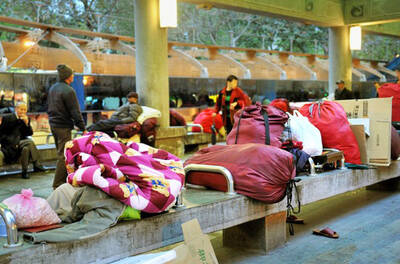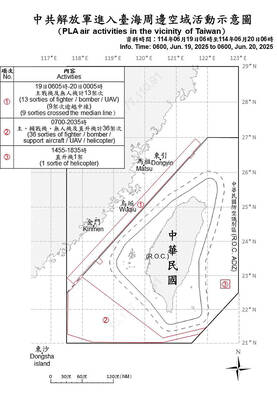The Taiwan High-Speed Rail Corp (THSRC) yesterday officially launched a new theme train from Taipei, with the train’s exterior featuring two popular cartoon characters created by Japanese illustrator Kanahei.
The company said that the train, featuring Piske (P助) and Usagi (粉紅兔兔), is to operate until September next year, adding that all high-speed rail passengers would have a chance to ride the new train in the next 10 months.
The company and Kanehei also released 14 co-branded items related to the new train, including pull-back trains, belt bags, stuffed animals, ticket holders and key chains.

Photo: Cheng Wei-chi, Taipei Times
Piske and Usagi are also appear on the uniforms of train conductors, on-board service personnel and station crew, THSRC Spokesperson Johnson Sun (孫鴻文) said yesterday.
As Piske and Usagi are good friends, the company hoped that the characters would convey the image that the high-speed rail is a good friend to every passenger, he said.
Sun also said that the company started selling Kanahei’s products before the launch of the train and that the sale of some items has exceeded the company’s expectations.
THSRC has also displayed the merchandise at its station in Taichung, where people can purchase the products from two vending machines.
A Taipei resident surnamed Ni (倪), an avid fan of Piske and Usagi, boarded the theme train yesterday to go to Taichung when she heard that THSRC was selling merchandise featuring her favorite cartoon characters.
Wearing a pink dress and carrying a Piske-shaped bag, Ni said that she thought the color of her outfit would go well with the cartoon characters.
Having spent about two to three years collecting merchandise, Ni said that her bedroom is filled with Kanahei’s products.
She bought a set of pull-back trains and a ticket card holder to add to her collection.
In related news, the THSRC said it aims to have 30 percent of its maintenance parts and materials produced by Taiwanese manufacturers by 2022.
THSRC executive vice president John Chen (陳強) said that since last year the company has been working to build up its own ability to maintain the system.
This year it has started to train personnel to repair and maintain power lines, the power supply system and railway tracks in classroom settings, he said.
This move is aimed at ensuring that trainees would learn to strictly follow standardized operating procedures.
Currently, 90 percent of train maintenance can be conducted by local staff, except for parts of the system involving patented techniques from Japan.
The company this year also began to use Taiwanese paint instead of Japanese paint to furbish the bodies of five trains, he said.
The paint’s quality is higher than that of Japanese paint, and testing in the past five months has shown that the paint is durable and resists erosion.
“We aim to have all the train sets furbished using Taiwanese paints by September next year,” he said, adding that the move would cut the original costs in half.

A year-long renovation of Taipei’s Bangka Park (艋舺公園) began yesterday, as city workers fenced off the site and cleared out belongings left by homeless residents who had been living there. Despite protests from displaced residents, a city official defended the government’s relocation efforts, saying transitional housing has been offered. The renovation of the park in Taipei’s Wanhua District (萬華), near Longshan Temple (龍山寺), began at 9am yesterday, as about 20 homeless people packed their belongings and left after being asked to move by city personnel. Among them was a 90-year-old woman surnamed Wang (王), who last week said that she had no plans

China might accelerate its strategic actions toward Taiwan, the South China Sea and across the first island chain, after the US officially entered a military conflict with Iran, as Beijing would perceive Washington as incapable of fighting a two-front war, a military expert said yesterday. The US’ ongoing conflict with Iran is not merely an act of retaliation or a “delaying tactic,” but a strategic military campaign aimed at dismantling Tehran’s nuclear capabilities and reshaping the regional order in the Middle East, said National Defense University distinguished adjunct lecturer Holmes Liao (廖宏祥), former McDonnell Douglas Aerospace representative in Taiwan. If

TO BE APPEALED: The environment ministry said coal reduction goals had to be reached within two months, which was against the principle of legitimate expectation The Taipei High Administrative Court on Thursday ruled in favor of the Taichung Environmental Protection Bureau in its administrative litigation against the Ministry of Environment for the rescission of a NT$18 million fine (US$609,570) imposed by the bureau on the Taichung Power Plant in 2019 for alleged excess coal power generation. The bureau in November 2019 revised what it said was a “slip of the pen” in the text of the operating permit granted to the plant — which is run by Taiwan Power Co (Taipower) — in October 2017. The permit originally read: “reduce coal use by 40 percent from Jan.

‘SPEY’ REACTION: Beijing said its Eastern Theater Command ‘organized troops to monitor and guard the entire process’ of a Taiwan Strait transit China sent 74 warplanes toward Taiwan between late Thursday and early yesterday, 61 of which crossed the median line in the Taiwan Strait. It was not clear why so many planes were scrambled, said the Ministry of National Defense, which tabulated the flights. The aircraft were sent in two separate tranches, the ministry said. The Ministry of Foreign Affairs on Thursday “confirmed and welcomed” a transit by the British Royal Navy’s HMS Spey, a River-class offshore patrol vessel, through the Taiwan Strait a day earlier. The ship’s transit “once again [reaffirmed the Strait’s] status as international waters,” the foreign ministry said. “Such transits by